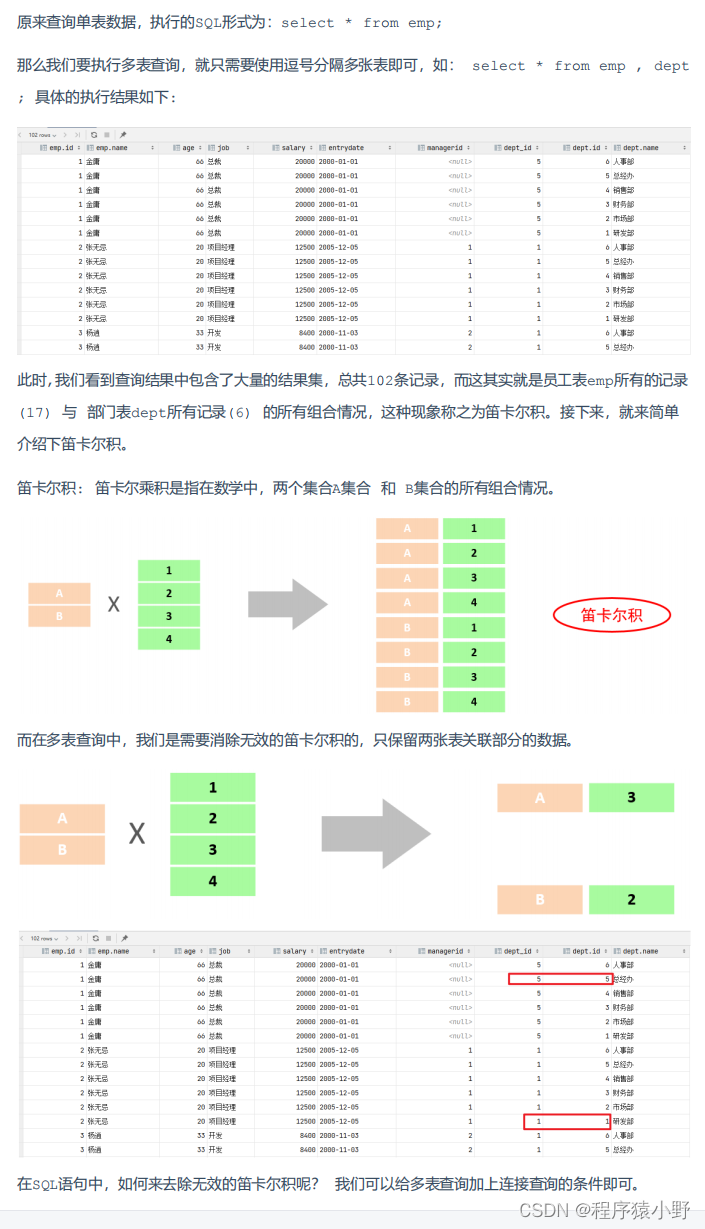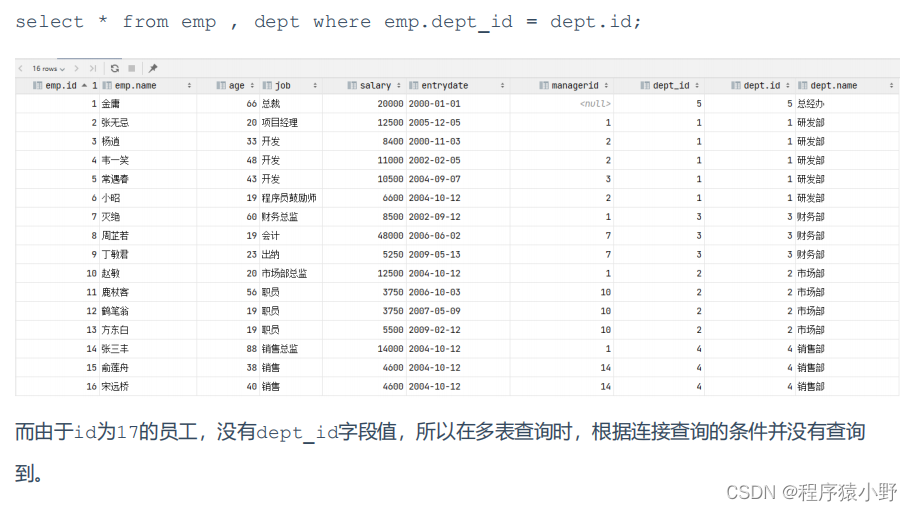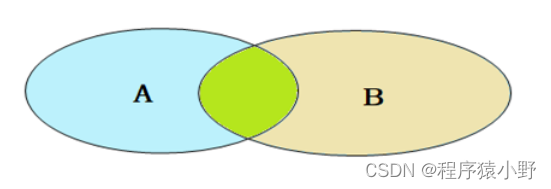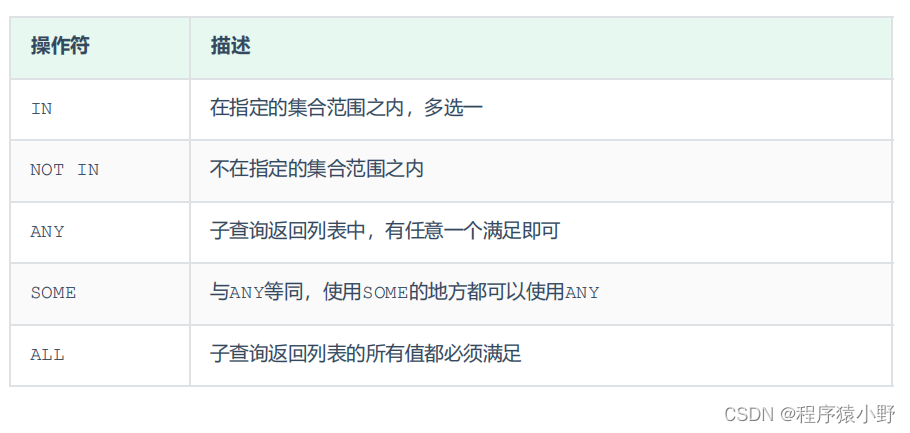版权申明:本文用于个人学习记录,学习课程为黑马程序员的mysql教程。如需获取官方的学习视频和文档资料,请至黑马程序员官方获取。下面附上教学视频的链接地址,向提供免费教学视频的老师致敬,学如逆水行舟,不进则退,共勉
黑马程序员 MySQL数据库入门到精通,从mysql安装到mysql高级、mysql优化全囊括_哔哩哔哩_bilibili
1、多表关系
- 一对多(多对一)
- 多对多
- 一对一
1.1 一对多
- 案例: 部门 与 员工的关系
- 关系: 一个部门对应多个员工,一个员工对应一个部门
- 实现: 在多的一方建立外键,指向一的一方的主键

1.2 多对多
- 案例: 学生 与 课程的关系
- 关系: 一个学生可以选修多门课程,一门课程也可以供多个学生选择
- 实现: 建立第三张中间表,中间表至少包含两个外键,分别关联两方主键
 对应的SQL脚本:
对应的SQL脚本:
-- 多表查询
create table student
(id int auto_increment primary key comment '主键ID',name varchar(10) comment '姓名',no varchar(10) comment '学号'
) comment '学生表';
insert into student
values (null, '黛绮丝', '2000100101'),(null, '谢逊', '2000100102'),(null, '殷天正', '2000100103'),(null, '韦一笑', '2000100104');create table course
(id int auto_increment primary key comment '主键ID',name varchar(10) comment '课程名称'
) comment '课程表';
insert into course
values (null, 'Java'),(null, 'PHP'),(null, 'MySQL'),(null, 'Hadoop');create table student_course
(id int auto_increment comment '主键' primary key,studentid int not null comment '学生ID',courseid int not null comment '课程ID',constraint fk_courseid foreign key (courseid) references course (id),constraint fk_studentid foreign key (studentid) references student (id)
) comment '学生课程中间表';
insert into student_course values (null,1,1),(null,1,2),(null,1,3),(null,2,2), (null,2,3),(null,3,4);1.3 一对一
- 案例: 用户 与 用户详情的关系
- 关系: 一对一关系,多用于单表拆分,将一张表的基础字段放在一张表中,其他详情字段放在另一张表中,以提升操作效率
- 实现: 在任意一方加入外键,关联另外一方的主键,并且设置外键为唯一的(UNIQUE)

对应的SQL:
create table tb_user
(id int auto_increment primary key comment '主键ID',name varchar(10) comment '姓名',age int comment '年龄',gender char(1) comment '1: 男 , 2: 女',phone char(11) comment '手机号'
) comment '用户基本信息表';create table tb_user_edu
(id int auto_increment primary key comment '主键ID',degree varchar(20) comment '学历',major varchar(50) comment '专业',primaryschool varchar(50) comment '小学',middleschool varchar(50) comment '中学',university varchar(50) comment '大学',userid int unique comment '用户ID',constraint fk_userid foreign key (userid) references tb_user (id)
) comment '用户教育信息表';insert into tb_user(id, name, age, gender, phone)
values (null, '黄渤', 45, '1', '18800001111'),(null, '冰冰', 35, '2', '18800002222'),(null, '码云', 55, '1', '18800008888'),(null, '李彦宏', 50, '1', '18800009999');
insert into tb_user_edu(id, degree, major, primaryschool, middleschool, university, userid)
values (null, '本科', '舞蹈', '静安区第一小学', '静安区第一中学', '北京舞蹈学院', 1),(null, '硕士', '表演', '朝阳区第一小学', '朝阳区第一中学', '北京电影学院', 2),(null, '本科', '英语', '杭州市第一小学', '杭州市第一中学', '杭州师范大学', 3),(null, '本科', '应用数学', '阳泉第一小学', '阳泉区第一中学', '清华大学', 4);2、多表查询概述
2.1 数据准备
-- 创建dept表,并插入数据
create table dept
(id int auto_increment comment 'ID' primary key,name varchar(50) not null comment '部门名称'
) comment '部门表';
INSERT INTO dept (id, name)
VALUES (1, '研发部'),(2, '市场部'),(3, '财务部'),(4, '销售部'),(5, '总经办'),(6, '人事部');-- 创建emp表,并插入数据
create table emp
(id int auto_increment comment 'ID' primary key,name varchar(50) not null comment '姓名',age int comment '年龄',job varchar(20) comment '职位',salary int comment '薪资',entrydate date comment '入职时间',managerid int comment '直属领导ID',dept_id int comment '部门ID'
) comment '员工表';-- 添加外键
alter table empadd constraint fk_emp_dept_id foreign key (dept_id) references dept (id);INSERT INTO emp (id, name, age, job, salary, entrydate, managerid, dept_id)
VALUES (1, '金庸', 66, '总裁', 20000, '2000-01-01', null, 5),(2, '张无忌', 20, '项目经理', 12500, '2005-12-05', 1, 1),(3, '杨逍', 33, '开发', 8400, '2000-11-03', 2, 1),(4, '韦一笑', 48, '开发', 11000, '2002-02-05', 2, 1),(5, '常遇春', 43, '开发', 10500, '2004-09-07', 3, 1),(6, '小昭', 19, '程序员鼓励师', 6600, '2004-10-12', 2, 1),(7, '灭绝', 60, '财务总监', 8500, '2002-09-12', 1, 3),(8, '周芷若', 19, '会计', 48000, '2006-06-02', 7, 3),(9, '丁敏君', 23, '出纳', 5250, '2009-05-13', 7, 3),(10, '赵敏', 20, '市场部总监', 12500, '2004-10-12', 1, 2),(11, '鹿杖客', 56, '职员', 3750, '2006-10-03', 10, 2),(12, '鹤笔翁', 19, '职员', 3750, '2007-05-09', 10, 2),(13, '方东白', 19, '职员', 5500, '2009-02-12', 10, 2),(14, '张三丰', 88, '销售总监', 14000, '2004-10-12', 1, 4),(15, '俞莲舟', 38, '销售', 4600, '2004-10-12', 14, 4),(16, '宋远桥', 40, '销售', 4600, '2004-10-12', 14, 4),(17, '陈友谅', 42, null, 2000, '2011-10-12', 1, null);2.2 概述

 2.3 分类
2.3 分类
- 连接查询
- 内连接:相当于查询 A 、 B 交集部分数据
- 外连接:
- 左外连接:查询左表所有数据,以及两张表交集部分数据
- 右外连接:查询右表所有数据,以及两张表交集部分数据
- 自连接:当前表与自身的连接查询,自连接必须使用表别名
-
- 子查询

3、内连接

1)隐式内连接
SELECT 字段列表 FROM 表1 , 表2 WHERE 条件 ... ;
2)显式内连接
SELECT 字段列表 FROM 表1 [ INNER ] JOIN 表2 ON 连接条件 ... ;
-- 内连接演示
-- 1. 查询每一个员工的姓名 , 及关联的部门的名称 (隐式内连接实现)
-- 表结构:emp,dept
-- 连接条件:emp.dept_id = dept.id
-- 16条数据,因为有一个员工没有部门信息
select emp.name, dept.name from emp, dept where emp.dept_id = dept.id;
-- 起别名, 起了别名就只能通过别名.
select e.name, d.name from emp e, dept d where e.dept_id = d.id;-- 2. 查询每一个员工的姓名 , 及关联的部门的名称 (显式内连接实现) --- INNER JOIN ... ON ...
-- 表结构:emp,dept
-- 连接条件:emp.dept_id = dept.id
select e.name,d.name from emp e inner join dept d on e.dept_id = d.id;
-- inner可以省略
select e.name,d.name from emp e join dept d on e.dept_id = d.id;表的别名 :①. tablea as 别名 1 , tableb as 别名 2 ;②. tablea 别名 1 , tableb 别名 2 ;
注意事项:一旦为表起了别名,就不能再使用表名来指定对应的字段了,此时只能够使用别名来指定字段。
4、外连接

1)左外连接
SELECT 字段列表 FROM 表1 LEFT [ OUTER ] JOIN 表2 ON 条件 ... ;
左外连接相当于查询表1(左表)的所有数据,当然也包含表1和表2交集部分的数据。
2)右外连接
SELECT 字段列表 FROM 表1 RIGHT [ OUTER ] JOIN 表2 ON 条件 ... ;
右外连接相当于查询表2(右表)的所有数据,当然也包含表1和表2交集部分的数据。
-- 外连接演示
-- 1. 查询emp表的所有数据,和对应的部门信息(左外连接)
-- 由于需求中提到,要查询emp的所有数据,所以是不能内连接查询的,需要考虑使用外连接查询。
-- 表结构:emp, dept
-- 连接条件:emp.dept_id = dept.id
-- 17条数据,左外连接会完全包含左表的数据
select e.*, d.name from emp e left outer join dept d on e.dept_id = d.id;
-- outer关键字可以省略
select e.*, d.name from emp e left join dept d on e.dept_id = d.id;-- 2. 查询dept表的所有数据,和对应的员工信息(右外连接)
-- 由于需求中提到,要查询dept表的所有数据,所以是不能内连接查询的,需要考虑使用外连接查询
-- 右外连接会包含所有右表的数据
select d.*, e.* from emp e right outer join dept d on e.dept_id = d.id;
-- 右外连接也可以改成左外连接
select d.*, e.* from dept d left outer join emp e on e.dept_id = d.id;注意事项:左外连接和右外连接是可以相互替换的,只需要调整在连接查询时SQL 中,表结构的先后顺序就可以了。而我们在日常开发使用时,更偏向于左外连接。
5、自连接
5.1 自连接查询
SELECT 字段列表 FROM 表 A 别名 A JOIN 表 A 别名 B ON 条件 ... ;
而对于自连接查询,可以是内连接查询,也可以是外连接查询。
-- 自连接
-- 1. 查询员工及其所属领导的名字
-- 表结构:emp
-- 16条数据
select a.name, b.name from emp a, emp b where a.managerid = b.id;-- 2. 查询所有员工emp及其领导的名字emp,如果员工没有领导,也需要查询出来
-- 17条数据
select a.name, b.name from emp a left join emp b on a.managerid = b.id;
select a.name '员工', b.name '领导' from emp a left join emp b on a.managerid = b.id;注意事项 :在自连接查询中,必须要为表起别名,要不然我们不清楚所指定的条件、返回的字段,到底是哪一张表的字段。
5.2 联合查询
对于union查询,就是把多次查询的结果合并起来,形成一个新的查询结果集。
SELECT 字段列表 FROM 表 A ...UNION [ ALL ]SELECT 字段列表 FROM 表 B ....;
- 对于联合查询的多张表的列数必须保持一致,字段类型也需要保持一致。
- union all 会将全部的数据直接合并在一起,union 会对合并之后的数据去重。
-- 联合查询
-- 对于联合查询的多张表的列数必须保持一致,字段类型也需要保持一致。
-- union all 会将全部的数据直接合并在一起,union 会对合并之后的数据去重。
-- union all, union
-- 1. 将薪资低于5000的员工,和年龄大于50岁的员工全部查询出来
-- 会有重复数据
select * from emp where salary < 5000
union all
select * from emp where age > 50;-- 去重
select * from emp where salary < 5000
union
select * from emp where age > 50;
-- select * from emp where salary < 5000 || emp.age > 50;
6、子查询
6.1 概述
SELECT * FROM t1 WHERE column1 = ( SELECT column1 FROM t2 );
子查询外部的语句可以是INSERT / UPDATE / DELETE / SELECT 的任何一个。
- 标量子查询(子查询结果为单个值)
- 列子查询(子查询结果为一列)
- 行子查询(子查询结果为一行)
- 表子查询(子查询结果为多行多列)
6.2 标量子查询
-- 子查询
-- 标量子查询
-- 子查询返回的结果是单个值(数字、字符串、日期等),最简单的形式,这种子查询称为标量子查询。
-- 常用的操作符:= <> > >= < <=
-- 1. 查询“销售部”的所有员工信息
-- a. 查询“销售部”部门ID
select id from dept where name = '销售部';
-- b. 根据销售部部门ID,查询员工信息
select * from emp where dept_id = 4;
-- 用一条sql子查询搞定
select * from emp where dept_id = (select id from dept where name = '销售部');-- 2. 查询在“方东白”入职之后的员工信息
-- a. 查询方东白的入职日期
select entrydate from emp where name = '方东白';
-- b. 根据方东白的入职日期,查询在“方东白”入职之后的员工信息
select * from emp where entrydate > '2009-02-12';
-- 合并
select * from emp where entrydate > (select entrydate from emp where name = '方东白');6.3 列子查询

-- 列子查询
-- 子查询返回的结果是一列(可以是多行),这种子查询称为列子查询。
-- 常用的操作符:IN 、NOT IN 、 ANY 、SOME 、 ALL
-- 1. 查询“销售部”和“市场部”的所有员工信息
-- a. 查询“销售部”和“市场部”的部门ID
select id from dept where name = '销售部' or name = '市场部';
-- b. 根据部门ID,查询员工信息
select * from emp where dept_id = 2 or dept_id = 4;
-- 合并
select * from emp where dept_id in (select id from dept where name = '销售部' or name = '市场部');-- 2. 查询比财务部所有人工资都高的员工信息
-- a. 查询所有财务部的人员工资
select salary from emp where dept_id = (select id from dept where name = '财务部');
-- b. 比财务部所有人工资都高的员工信息
select * from emp where salary > all (select salary from emp where dept_id = (select id from dept where name = '财务部'));-- 3. 查询比研发部其中任意一人工资高的员工信息
-- a. 查询研发部所有人工资
select salary from emp where dept_id = (select id from dept where name = '研发部');
-- b. 比研发部任意一人工资高的员工信息
select * from emp where salary > any (select salary from emp where dept_id = (select id from dept where name = '研发部'));
-- any\some 一个满足条件就行
select * from emp where salary > some (select salary from emp where dept_id = (select id from dept where name = '研发部'));6.4 行子查询
子查询返回的结果是一行(可以是多列),这种子查询称为行子查询。
-- 行子查询
-- 子查询返回的结果是一行(可以是多列),这种子查询称为行子查询。
-- 常用的操作符:= 、<> 、IN 、NOT IN
-- 1. 查询与 "张无忌" 的薪资及直属领导相同的员工信息
-- a. 查询"张无忌"的薪资及直属领导
select salary, managerid from emp where name = '张无忌';
-- b. 查询与 "张无忌" 的薪资及直属领导相同的员工信息
select * from emp where (salary,managerid) = (select salary, managerid from emp where name = '张无忌');6.5 表子查询
-- 表子查询
-- 子查询返回的结果是多行多列,这种子查询称为表子查询。
-- 常用的操作符:IN
-- 1. 查询与 "鹿杖客" , "宋远桥" 的职位和薪资相同的员工信息
-- a. 查询 "鹿杖客" , "宋远桥" 的职位和薪资
select job, salary from emp where name = '鹿杖客' || name = '宋远桥';
-- b. 查询与 "鹿杖客" , "宋远桥" 的职位和薪资相同的员工信息
select * from emp where (job,salary) in (select job, salary from emp where name = '鹿杖客' || name = '宋远桥');-- 2. 查询入职日期是 "2006-01-01" 之后的员工信息 , 及其部门信息
-- a. 入职日期是 "2006-01-01" 之后的员工信息
select * from emp where entrydate > '2006-01-01';
-- b. 查询这部分员工, 对应的部门信息;
select e.*, d.* from (select * from emp where entrydate > '2006-01-01') e left join dept d on e.dept_id = d.id;7、多表查询案例
-- 多表查询案例
-- 准备工作,创建薪资等级表,并且插入数据
create table salgrade(grade int,losal int,hisal int
) comment '薪资等级表';
insert into salgrade values (1,0,3000);
insert into salgrade values (2,3001,5000);
insert into salgrade values (3,5001,8000);
insert into salgrade values (4,8001,10000);
insert into salgrade values (5,10001,15000);
insert into salgrade values (6,15001,20000);
insert into salgrade values (7,20001,25000);
insert into salgrade values (8,25001,30000);-- 1. 查询员工的姓名、年龄、职位、部门信息 (隐式内连接)
-- 表: emp , dept
-- 连接条件 : emp.dept_id = dept.id
select e.name, e.age, e.salary, d.* from emp e, dept d where e.dept_id = d.id;-- 2. 查询年龄小于30岁的员工的姓名、年龄、职位、部门信息(显式内连接)
-- 表: emp , dept
-- 连接条件 : emp.dept_id = dept.id
select e.name, e.age, e.salary, d.* from emp e join dept d on d.id = e.dept_id where e.age < 30;-- 3. 查询拥有员工的部门ID、部门名称
-- 表: emp , dept
-- 连接条件 : emp.dept_id = dept.id
-- distinct 对查询结果去重
select distinct d.id, d.name from emp e, dept d where e.dept_id = d.id;-- 4. 查询所有年龄大于40岁的员工, 及其归属的部门名称; 如果员工没有分配部门, 也需要展示出来(外连接)
-- 表: emp , dept
-- 连接条件 : emp.dept_id = dept.id
-- 外连接
select e.*, d.name from emp e left outer join dept d on d.id = e.dept_id where e.age > 40;-- 5. 查询所有员工的工资等级
-- 表: emp , salgrade
-- 连接条件:emp.salary >= salgrade.losal and emp.salary <= salgrade.hisal
select e.*, s.grade, s.losal, s.hisal from emp e, salgrade s where e.salary >= s.losal && e.salary <= s.hisal;
-- 另一种写法
select e.*, s.grade, s.losal, s.hisal from emp e, salgrade s where e.salary between s.losal and s.hisal;-- 6. 查询 "研发部" 所有员工的信息及 工资等级
-- 表: emp , salgrade , dept
-- 连接条件 : emp.salary between salgrade.losal and salgrade.hisal ,
-- emp.dept_id = dept.id
-- 查询条件 : dept.name = '研发部'
select e.*, s.grade
from emp e,dept d,salgrade s
where (e.salary between s.losal and s.hisal and e.dept_id = d.id)and d.name = '研发部';-- 7. 查询 "研发部" 员工的平均工资
-- 表: emp , dept
-- 连接条件 : emp.dept_id = dept.id
select avg(e.salary) from emp e, dept d where e.dept_id = d.id and d.name = '研发部';-- 8. 查询工资比 "灭绝" 高的员工信息
-- select salary from emp e where e.name = '灭绝';
select * from emp where salary > (select salary from emp e where e.name = '灭绝');-- 9. 查询比平均薪资高的员工信息
-- select avg(salary) from emp;
select * from emp where salary > (select avg(salary) from emp);-- 10.查询低于本部门平均工资的员工信息
select avg(salary) from emp where dept_id = 1;
select avg(salary) from emp where dept_id = 2;
select * from emp e where salary < (select avg(salary) from emp where dept_id = e.dept_id);-- 11. 查询所有的部门信息, 并统计部门的员工人数
-- select count(*) from emp where dept_id = 1;
select d.id, d.name, (select count(*) from emp e where e.dept_id = d.id) '人数' from dept d;-- 12. 查询所有学生的选课情况, 展示出学生名称, 学号, 课程名称
-- 表: student , course , student_course
-- 连接条件: student.id = student_course.studentid , course.id = student_course.courseid
select s.name,s.no,c.name from student s, student_course sc, course c where s.id = sc.studentid and sc.courseid = c.id;





-原理图-PCB设计+源程序)








)

)
